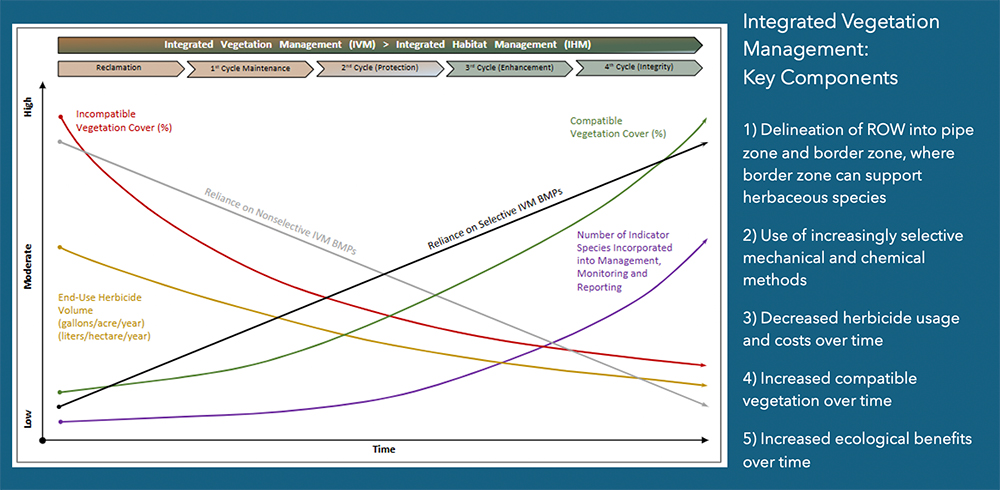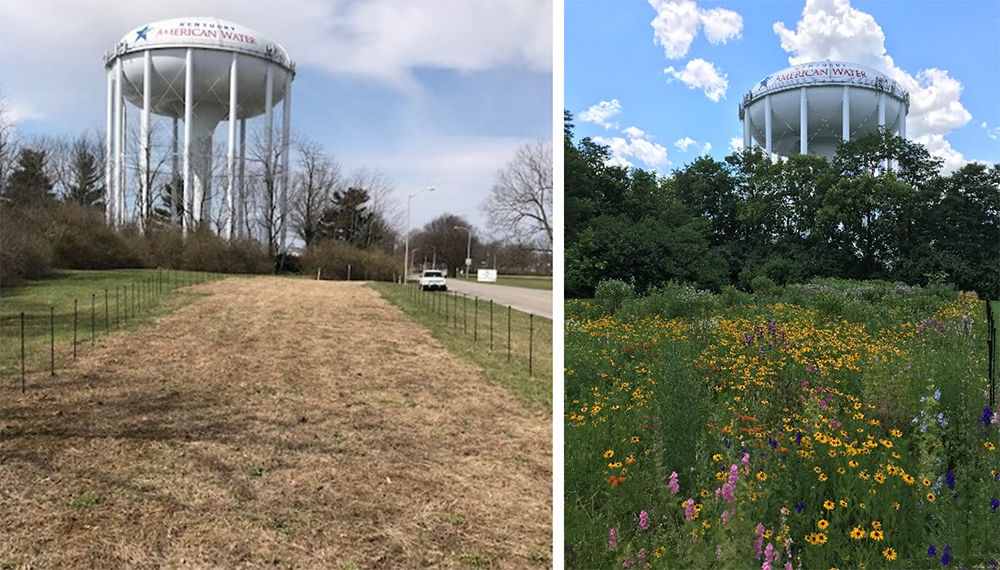March 2025, Vol. 252, No. 3
Features
Case Study: Planting a Seed for a Brighter Future
By Susan Murray, Land Technician II/Survey & Land, Columbia Gas, a NiSource company
(P&GJ) — In 2015, a lecture by Kentucky State Apiarist Tammy Horn Potter transformed the way I thought about vegetation management on the right-of-way (ROW). She described the exciting potential of managing ROWs, not just for utility needs but also as pollinator habitats. I was (and am to this day) a land technician for Columbia Gas, where I manage vegetation on some 35,000 miles of gas line rights-of-way.
We had, up to that point, been mowing everything, a safe and standard — but ultimately ecologically devoid — process. What Horn Potter proposed instead was to encourage low-growing forbs and flowers on the ROW, to transform these landscapes into thriving ecosystems that could benefit biodiversity while also meeting utility objectives.
WATCH NOW: CG Land Owners Video on Vimeo
Pollinator populations in the United States are experiencing rapid declines, due to a variety of reasons, some of which include habitat loss, pesticide use and disease. Over 50% of native bee species are in decline and nearly 25% are at risk of extinction, largely due to habitat destruction and agricultural intensification (USGS, 2017).
Monarch butterflies, essential pollinators, have seen eastern populations decline by 80% and western populations by 95% since the 1980s, primarily because of habitat loss (AP News, 2024). Honeybee colonies also face annual mortality rates exceeding 39%, driven by threats such as Varroa mites, Colony Collapse Disorder and pesticide exposure (Lee et al., 2023).
These losses jeopardize ecosystems and U.S. agriculture, emphasizing the urgent need for conservation efforts. The point that Horn Potter drove home was, with millions of acres of managed ROWs, utilities had an unparalleled opportunity to restore critical habitat at a massive scale.
The idea immediately struck a chord.
It felt like a sign; it was time for us to stop viewing ROWs through a mowing mindset and start new processes whose benefits extended beyond utility management. With support from our department manager, Tony Tipton, I was supercharged about what we could do — I knew we could make a difference.
Dreaming Big
We started the process of transforming our vegetation management operations through two key components: implementing integrated vegetation management and planting pollinator plots at key locations throughout our ROW footprint.
Integrated vegetation management (or IVM) involves dividing the ROW into two zones: the pipe zone — which is mowed for access — and the border zone, which allows for taller herbaceous vegetation. We work with key contractors ArborMetrics (planning) and Forrell Innovation (implementation) to use increasingly selective mechanical and chemical methods to promote the growth of structurally compatible and ecologically beneficial herbaceous plants and grasses.
The border zone concept gradually transforms the ecological desert of mowed grass into habitat for pollinators, birds, reptiles, amphibians and even small and large mammals (some of whom help clear the ROW of structurally incompatible tree seedlings and saplings) (Mahan et al., 2021). IVM is a process that takes time but has been shown to considerably decrease program costs associated with mowing and herbicides over the long run (Figure 1, ESG Biodiversity Handbook. EPRI).

In the meantime, we began establishing pollinator plots on a project basis across Columbia Gas’s footprint. We chose public-facing sites where the opportunity to add aesthetic value for the community further enhanced the ecological value, as well as sites where we had partners committed to collaborating on establishment and management.
These efforts have blossomed into a network of 24 pollinator plots (and counting) across Ohio, Pennsylvania, Virginia and Kentucky. Within our pollinator plots, which range from half an acre to six acres or more, we promote a healthy ratio of grasses to herbaceous plants.
The seed mixes are designed to foster annuals, biennials and perennials, with particular importance placed upon having constant blooms available from early spring to late fall. Each plot is a testament to the transformation from grass-dominant ROWs to vibrant habitats teeming with bees, butterflies and other pollinators.
Partnerships
None of this would have happened if we had tried to do it on our own. Early conversations with members of organizations like the Right-of-Way Habitat Working Group, Wildlife Habitat Council, and Monarch Watch provided critical support, from site reclamation and planting logistics to long-term maintenance.
Roundstone Native Seed and Ernst Seeds not only supplied ecoregion-specific native seed mixes but also shared a wealth of knowledge on how to convert grass to pollinator habitat. Meanwhile, ArborMetrics continued to perform vegetation management planning, with Forell Innovation performing high quality, on-the-ground implementation. In addition, Grow With Trees provided training and consultation regarding compatible and desirable species management.
Public institutions like the University of Kentucky, Blue Grass Airport and Lexington Parks and Recreation have emerged as enthusiastic allies, hosting pollinator plots on their campuses and contributing toward maintenance. Community groups have also stepped in, tackling invasive species removal and spreading the word about the urgent need to support pollinator populations. A community group called The Rachel Carson Trail Conservancy (RCTC), near Pittsburg, PA, has been an avid partner in a variety of pollinator projects and activities.
RCTC member Bob Mulshine said, “One of the trails we maintain, the Harmony Trail, shares a right-of-way with Columbia Gas. Our volunteers have long worked to control the invasives near the trail. We were glad to expand our mission to making the area more productive for pollinators.
The supplies of seed and seedlings we were given by Columbia Gas not only improved the biodiversity along the trail, but it also got more volunteers engaged, made the view from the trail more pleasing and increased the number of people using the trail. We see a long-term impact each month during the growing season as different plants bloom and each year, we have seen interesting increases and decreases of pockets of various plants.”
Getting buy-in across departments inside Columbia Gas has been equally critical, though not without its challenges. On the one hand, the environmental department saw the work we were doing and loved it, quickly becoming a source of support. In fact, they were instrumental in helping us get the word out within the company about the opportunity to support biodiversity in a manner consistent with the work we are already doing.
On the other hand, others were not such early fans. Some, for example, were afraid of bee stings and here I was trying to create bee gardens! Taking the time to educate other departments on the safety of pollinators as they forage eased concerns and gradually gained cross-departmental buy-in.
Other efforts took even longer. It required nine years of persistent effort, outreach, and encouragement from across departments to finally start utilizing pollinator seed mixes rather than standard mixes on post-construction sites, for example. It’s important not to give up. Find those who can help you, tell your story, and keep at it.
Growing Legacy
The Masterson Park pollinator plot in northern Lexington, Kentucky is a great example of why we keep going. It started as a mowed, ecologically destitute strip of invasive Johnsongrass between a field and a main road. Today, it’s a vibrant, thriving community of wildflowers, bees, butterflies, and other insects, with its prominent roadside location adding beauty to the area and to the park.
As Chris Cooperrider, deputy director of Lexington, Kentucky’s Parks and Recreation shared, “Lexington’s Division of Parks and Recreation did a broad outreach in developing the 2018 Parks Masterplan that was approved by City Council. One of the top five action items was to create more naturalized parks and programming.
Using utility corridors within existing parks in partnership with Columbia Gas has helped to achieve one of our citizen-driven goals. The site at Masterson Station is now a model for other similar efforts within Lexington Parks.”
There are also economic benefits, such as decreasing time and fuel costs associated with mowing these strips, but the ecological benefits are even greater. Even small patches of pollinator habitat, like Lexington’s Mercer Road plot (Fig. 2), have been shown to have disproportionately large benefits to pollinator species diversity and abundance, according to a recent meta-analysis (Donkersley et al. 2023).
Furthermore, these plots have inspired some community partners to increase their pro-pollinator efforts. One example is the University of Kentucky, which is seeking to expand its pollinator habitat multi-fold, from half an acre to six acres.

Leaders at Columbia Gas and its parent company, NiSource, are paying attention to our pollinator plots as well. Our efforts to promote habitat align with a growing corporate recognition of and commitment to biodiversity. NiSource has enrolled all managed acreage in the Monarch Butterfly Candidate Conservation Agreement with Assurances (Monarch CCAA), a program which promotes conservation-aligned land management to support monarch butterfly habitat.
This agreement not only furthers ecological goals through conservation-aligned management of ROWs, but it also provides protections to the company from further regulatory restrictions and liabilities, should the monarch butterfly be listed as threatened or endangered. Our pollinator plots, now numbering over 50 acres combined, are counted toward the Monarch CCAA habitat target, showcasing how working landscapes can benefit both business and nature.
The importance of education cannot be understated. Only last year, it was discovered that some (likely well-meaning) members of the public had removed all of the milkweed from certain pollinator plots, a critical food source for Monarch butterfly young. In other cases, as pollinator plots underwent their “ugly duckling” stages of reclamation and early groundcovers, public concerns and complaints arose, surfacing primarily over social media.
While some partners diligently responded to online concerns, we also put up public signage with QR codes taking passers-by to a video describing our goals. In a matter of a few years, and as flowers were established abundantly, we have seen much more enthusiasm from the general public. From happy pollinators and enthusiastic community groups to inspired artists and greater corporate-level biodiversity commitment, the pollinator plots are bringing benefits that far exceed their humble size.
Scaling Up
The future holds even greater ambitions, as Columbia Gas transitions from a project-based approach to a program-level commitment. The value of protecting and enhancing biodiversity is an idea that is rapidly gaining traction across social, governmental and corporate landscapes. Now is the time to shift toward more ecologically based vegetation management of gas line ROWs, and we are excited to take on the challenge of applying lessons learned from small pollinator plots to the vegetation management of tens of thousands of acres.
These projects have not only transformed landscapes into beautiful and biodiverse habitats, but they have also transformed the way we think and feel about our managed lands.
Literature
Associated Press. (2024, December 1). Monarch butterflies to be listed as a threatened species in the US. AP News. https://apnews.com/article/f5d4844289ede7b3d76918cc6f98a5cc
Donkersley, P., Witchalls, S., Bloom, E.H., and Crowder, D.W. 2023. A little does a lot: Can small-scale planting for pollinators make a difference? Agriculture, Ecosystems & Environment, 343: 108254. https://www.sciencedirect.com/science/article/pii/S0167880922004030?via%3Dihub
Electric Power Research Institute (EPRI). (2022). ESG Biodiversity Handbook. EPRI, Palo Alto, CA. Report No. 3002024725. https://www.epri.com/research/products/3002024725
Lee, K., Smith, J., & Johnson, R. (2023). Annual mortality rates of honey bee colonies and their drivers in the United States. Journal of Apicultural Research, 62(1), 12–20. https://doi.org/10.1080/00218839.2023.2191043
Mahan, C., Ross, B., Stout, H., & Fisher, I. (2021). Floral and faunal research on utility rights-of-way at State Game Lands 33, State Game Lands 103, and Green Lane Research and Demonstration Areas. Pennsylvania State University. https://bpb-us-e1.wpmucdn.com/sites.psu.edu/dist/b/35926/files/2016/02/2021_FLORAL-AND-FAUNAL_Report.pdf
U.S. Geological Survey. (2017). Native bee populations at risk of extinction in the United States. USGS Publications Warehouse. https://pubs.er.usgs.gov/publication/fs20173060





Comments